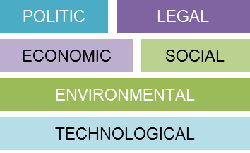4.3.9 PESTLE AND MATRICES TO CLASSIFY THE POSSIBLE CHANGES


4.3.9.1 PESTLE analysis
A PESTLE analysis is a means to organize the ideas, trends or possible changes in the future into different categories: Political, Economic, Social, Technological, Legal, and Environmental.

This analysis can be condcuted during a stakeholder workshop or internally to help you to implement the analysis of the system studied. A PESTLE analysis can be useful to:
- Identify the links between environment and human activities
- Identify possible changes in the future that can be used to build scenarios
If you use a PESTLE analysis for scenario building, you will need to discuss a common focus with participants, as well as the system studied, “What possible changes or trends could happen in the future, concerning the political, economic, social, technological, legal, and environmental aspects?”.
If you aim to build exploratory scenarios, there is no limit to the imagination of participants whereas if you build normative scenarios, the participants are limited in their options by the fact that they have to reach the objective to achieve a result.
A PESTLE analysis describes a framework of macro-environmental factors used in helping to identify the different driving forces in play in a particular situation.
Sometimes this is also represented as PEST (without the Legal and Environmental). It is a very useful and widely employed tool as it offers a wide-ranging framework from which to build scenarios [While, 2010].
Time: ½ day to 1 day
Technical level: 2/4
Advantages: permits the organisation of ideas, not forgetting any category. Involves participants in analyzing the system or the options for scenarios. Contributes to creating a common understanding of a subject. Creates debate.
Resources needed: a facilitator, materials (pencils, brown-paper, flip-charts etc).
Advice: the facilitators should be prepared for the potential results (complete the exercise yourself before the workshop).
Some ideas can be prepared before the workshop as “starters” to be kept or not by the participants, in order to initiate the working groups.

Example of a PESTLE analysis realized to develop exploratory scenarios concerning the adaptation of coastal populations under climate change (IMCORE project developped in the Gulf of Morbihan).
During a workshop, the participants were divided into 3 groups to identify:
- Group 1: the possible environmental and social changes
- Group 2: the possible political and legal changes
- Group 3: the possible technological and economical changes
For each possible change, participants must give a clear indication of the meaning, such as the trend (increase / decrease) or a movement. After about an hour the participants in the working groups share their ideas by writing them on posts-it notes. The facilitator then combines similar proposals and facilitates the discussion to explain the meaning of each idea. The next step is to identify the possible changes as stakeholders classified them on an “importance/uncertainty” matrix.


